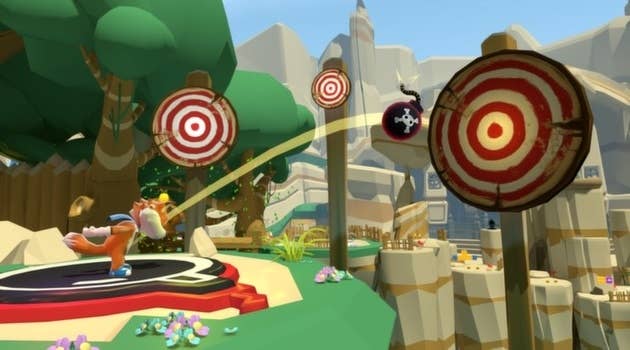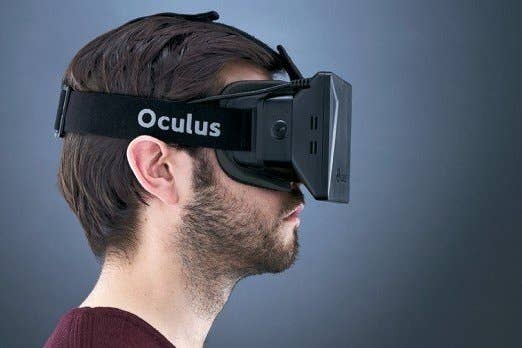Oculus VR: Finding the Holodeck Solution
With the hardware taking shape, Palmer Luckey and Nate Mitchell are now turning their attention to content
When Oculus VR started to seriously consider its future as a business, it laid out two roadmaps. The first one is what vice president of product Nate Mitchell describes as "the plausible," a baseline of hardware, support and services that would be necessary to establish a consumer market for virtual reality. The second was "the impossible," a path that demanded a far larger checking account. Actually having the chance to use the latter roadmap was the stuff of a lazy afternoon's reverie.
The Facebook deal changed that. On a fundamental level, Mitchell says, the company's vision for both the Rift and the VR market as a whole are the same, but every one of its targets can now be amplified. "So instead of having, say, X amount of dollars to invest in VR content publishing, suddenly it's X multiplied by 10. It just means we can make a better platform for VR."
"The good news with having such a big backer behind us is that we can now afford to play that long game"
This is perhaps the most important perspective on the Facebook acquisition. Some of the Oculus Rift's Kickstarter backers felt cheated by the company's decision to sell up before the consumer product had reached the market. Others with an interest in the evolution of VR technology saw Facebook as a corporate overlord poised to spam this exciting new field with pop-up ads and free-to-play farming games. But here's the hard fact of the matter: there's a lot more work to be done before VR becomes a mainstream concern, and the assistance of a company like Facebook may well be critical to ensure that it happens at all, and that Oculus will be leading the way when it does.
"It might be next year, it might be five years from now," says Palmer Luckey, the founder or Oculus VR and the inventor of the Rift. "Maybe VR doesn't really take off for consumers for some time, but the good news at having such a big backer behind us is that we can now afford to play that long game. Rather than having to make money now or we stop existing and someone else takes over, we can think about the best thing to do for the long term of virtual reality."

Luckey and Mitchell are at Gamescom to introduce the press to the Rift's second development kit, widely referred to as "DK2." So far, Oculus VR has taken nearly 60,000 pre-orders from developers eager to experiment with the DK2's positional tracking and low-persistence OLED display. Around 20,000 units have already shipped, and while the team at Oculus VR is still locking down the spec for the consumer product, Luckey says that the DK2 has all of the vital components that will be in the final version.
The issue right now is content. In the last 12 months the Oculus Rift has been embraced by the full spectrum of entertainment media: appearing at prominent trade shows like South by Southwest, Sundance and the Tribeca Film Festival, supporting a diverse range of experiences, from interactive rock concerts to climbing Game of Thrones' icy wall. Ultimately, affiliations with music, television and cinema may prove to be vital if VR is to reach a truly mainstream audience, but both Luckey and Mitchell believe that the most exciting work will be done in the games industry. That's where passive experiences simply don't fly. That's where you'll find the immersive worlds.
"The content is the part where there's still unknowns. That's where we'll have to work hard to make sure that it comes together"
For now, though, it's still difficult to imagine the form those immersive worlds will take, and the ways in which players will be able to experience them. Up to this point, Oculus demos have shared a handful of common traits: they are, for the most part, relatively brief; they often involve a seated or static player avatar; and when the avatar has freedom of movement they almost always require the use of a traditional input device, normally a console control-pad with its myriad buttons, sticks and triggers.
These traits, Luckey says, are simply evidence of a growing community of developers trying to locate and answer the "hard problems" they will face when developing virtual reality products for consumers. That's why Oculus launched Share, a platform where developers can, "try things, get ideas, and share feedback."
"That's why we have a comments system and a feedback system. We even have a feedback system specifically for simulation sickness. There are a lot of devs who want to put stuff out on Share even when it's not really working all that well. I should point out that Share is not just an open free for all. We actually do have some guidelines to get in. We get a lot of submissions that are just completely broken, and we don't put those up. We test every single thing."
While that desire to ensure every demo on Share is at least useful isn't exactly the same thing as quality control, both Mitchell and Luckey claim that such concerns are very much at the forefront of their thinking. Oculus is long past the point of convincing the world that the Rift works at all; it now needs to prove just how amazing VR can be when it works as well as possible. Two examples of that are available as demos at Gamescom: Lucky's Tale, a charming 3D platformer from Playful, the studio co-founded by Words With Friends creator Paul Bettner; and Superhot, a stylish first-person shooter built around a unique relationship between the passage of time and navigating space. Indeed, Oculus will actually publish Lucky's Tale, the first and certainly not the last time the company will lend its support on that way.

"For this platform to be as great as it can be it's all about content," says Mitchell. "With publishing, it's not just about what shows off the tech; it's about what is actually going to make people go out and buy a Rift. And that's been one of the gating factors to the consumer version, in the sense that a lot of people would buy the DK2 right now. But if you did that you would have no games to play. We need to help seed the ecosystem and remove that risk for developers. Super important."
However, while Lucky's Tale and Superhot may be among the best examples of VR gaming to date, they are also fairly traditional at their core. Both require a controller, and feature only a couple of moments where the Rift seems to add a new way to interact rather than just a new perspective. As developers explore the technology, qualities like "immersion" and "presence" have emerged as ideal states for the player, and reaching them requires a limit to the number of abstractions in the design of any given experience. The inconvenient truth is that a traditional controller is one big, bulky abstraction, and one that developers will struggle to overcome.
"I don't think a controller is going to be the answer for VR - at least, not the kind that people are traditionally using"
"Controllers are a necessary abstraction right now, but a controller is not the ideal VR input," says Luckey. "You want something that's able to track your body movements, by haptic feedback and all these different things. But it's very challenging to do that, because people have been designing games for traditional controllers for a long time. So it's something that we're actively researching and developing, but I don't think a controller is going to be the answer for VR - at least, not the kind that people are traditionally using. It just makes sense for right now, because it's something that everybody has."
According to Mitchell, even devices like Microsoft's Kinect and Leap Motion aren't good enough to augment the VR experience in the right way. They're capable enough to be used for "interesting experiments," glimpses at what a true VR experience might be like. But at present the "Holodeck Solution" - effectively the Holy Grail of virtual reality - simply doesn't exist. And even if it did, for developers to create content for VR with any real confidence it would have to be sold as an integral part of the Oculus Rift.
"Developers aren't going to target those until it's something that's part of the VR platform," Luckey says of more sophisticated sensors that could track full-body movement. "They're not going to say, 'We've got this great thing, now you've just got to go out and buy an extra $300 or $400 worth of hardware from other companies and set it all up'."
The fact that Oculus is actively trying to tackle this issue is heartening, but it would be unwise to expect a solution before the consumer version of the Rift is released. After speaking to Luckey and Mitchell, it's clear that locomotion is just one of many unresolved pain-points when it comes to designing quality content for virtual reality. The remaining work that needs to be done on the headset is simple by comparison.
"We already have a roadmap for what we're going to ship," Luckey says. "The content is the part where there's still unknowns. That's where we'll have to work hard to make sure that it comes together."

